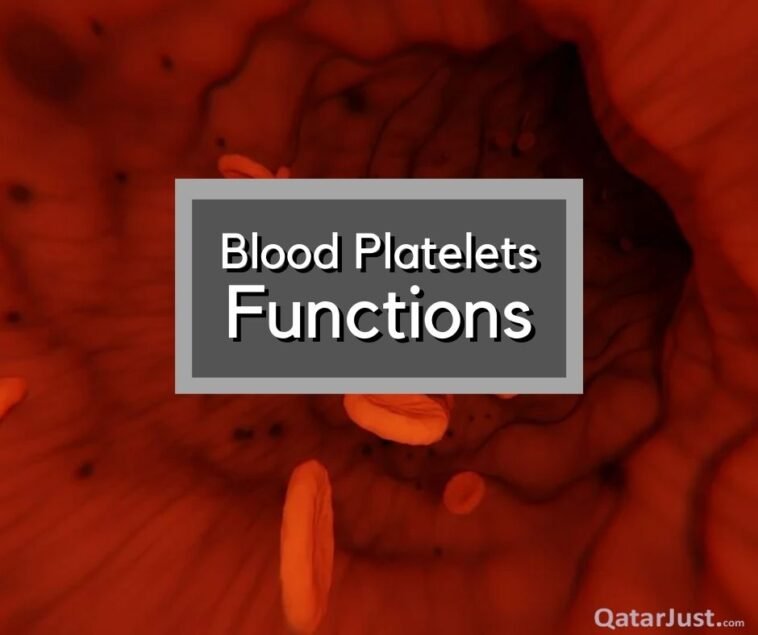Clotting occurs because of platelets, also called thrombocytes. In case of blood vessel wall damage, platelet clumps will form to stop bleeding at the site of injury. Low platelet counts (thrombocytopenia) can lead to uncontrolled or prolonged bleeding. An excess of platelets in the blood (thrombocytosis) can lead to abnormal blood clots, which can make people critically ill.
Your doctor can help you assess your platelet count by looking at the complete blood count (CBC) test. The root thrombo in thrombocyte means clot. You’ll see it used with diseases and conditions that affect platelets and blood clotting.
Work of Platelets
There are 3 types of blood cells (red blood cells, white blood cells, and platelets) that arise from the bone marrow from cells called megakaryocytes.
It is adhesion that forms clots from platelets. A severe cut will cause a blood vessel in your finger to rupture, causing it to bleed. This chemical signal is sent out by platelets within a broken vessel to assist in stopping the bleeding.
Several platelets respond to the call and begin to aggregate, a process called aggregation. A plug or clot forms in the blood vessel wall and triggers the clotting (coagulation) cascade, which then binds fibrin (a structural protein) to the plug or clot, knitting it together. The scab you see at a cut site is caused by fibrin.
Test & Platelets
A complete blood count (CBC) is a lab test that analyzes the makeup and chemistry of blood. It provides information on the number, size, and health of platelets. As far as platelets are concerned, there are the following markers:
Platelet Count (PLT)
In simple terms, this is your blood’s actual level of platelets (per microliter).
- Low Range- Platelets per microliter below 150,000
- Normal Range- Platelets per microliter: 150,000-450,000
- Elevated Range- Platelets per microliter: 500,000-1,000,000
In the absence of 50,000 platelets, you may suffer prolonged bleeding.
Mean Platelet Volume (MPV)
An average platelet volume is the size of an average platelet. The younger the platelets, the faster you produce and release them, while the lower the number, the more altered the bone marrow’s production will be.
The bloodstream contains platelets for about eight to ten days.
Platelet Distribution Width (PDW)
An abnormal variation in the size of platelets may indicate a condition that affects the platelets. If there are symptoms of or potential for excessive bleeding, platelet function tests may also be performed. Antiplatelet medications may also be monitored.
Causes of Low Platelet Count
An insufficient supply of platelets in the bloodstream can cause thrombocytopenia. Low platelet counts are caused by several factors:
- Chemotherapy or radiation therapy: These treatments reduce blood production by killing off platelets (megakaryocytes) in the bone marrow.
- Viral Infection: Infections with Hepatitis C or HIV may affect thrombocyte production by attacking bone marrow.
- ITP and lupus are autoimmune conditions
- Pregnancy: Blood cells and platelets are broken down in HELLP, otherwise known as pre-eclampsia. The condition can result in bleeding, elevated liver enzymes, and low platelet counts.
- Medications: Heparin and warfarin inhibit platelet production.
Causes of High Platelet Count
Too many platelets in the body can lead to thrombocytosis. High platelet counts are often caused by:
- Primary bone marrow disorder: An essential thrombocytosis is a condition in which the megakaryocytes in the bone marrow produce too many platelets, increasing the risk of blood clots.
- Chronic inflammation in the body: As inflammation increases, blood platelet counts may also rise as rheumatoid arthritis (RA) and inflammatory bowel disease (IBD) may induce the bone marrow to produce more white blood cells and platelets to counteract cellular damage.
- Infection: To fight infection, bone marrow cells increase the production of white blood cells and platelets.
- Iron deficiency anemia: Thrombocytosis can result from red blood cell breakdown and overproduction of bone marrow cells to meet the demand for red blood cells.
- Spleen removal: The spleen can store up to one-third of all platelets at any time, which means that removing it would cause a rise in platelet concentration in the bloodstream. However, this is usually a temporary condition.
- Cancer: Cancer can cause high platelet counts as well, most commonly in gastrointestinal cancer, as well as lymphoma, liver, ovarian, and breast cancer. Inflammation associated with the malignancy stimulates the bone marrow to produce platelets.
Further, there is a chance that the platelet count will rise after major surgery or trauma.
Please Subscribe Us to get updated with Qatar News, Saudi News, Kuwait News, Health News, UAE News, Iqama, Visa, Jobs, Banking and More.



